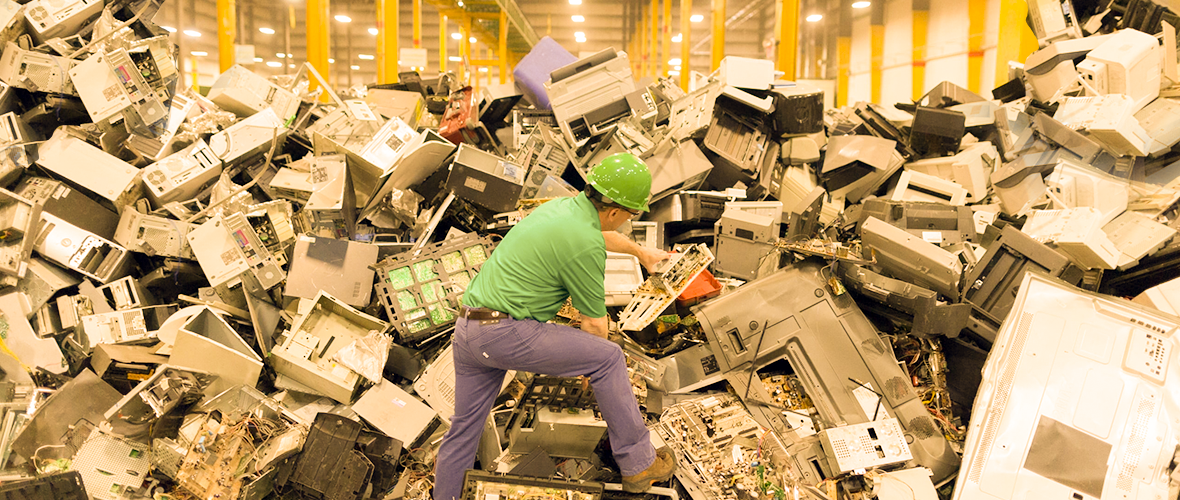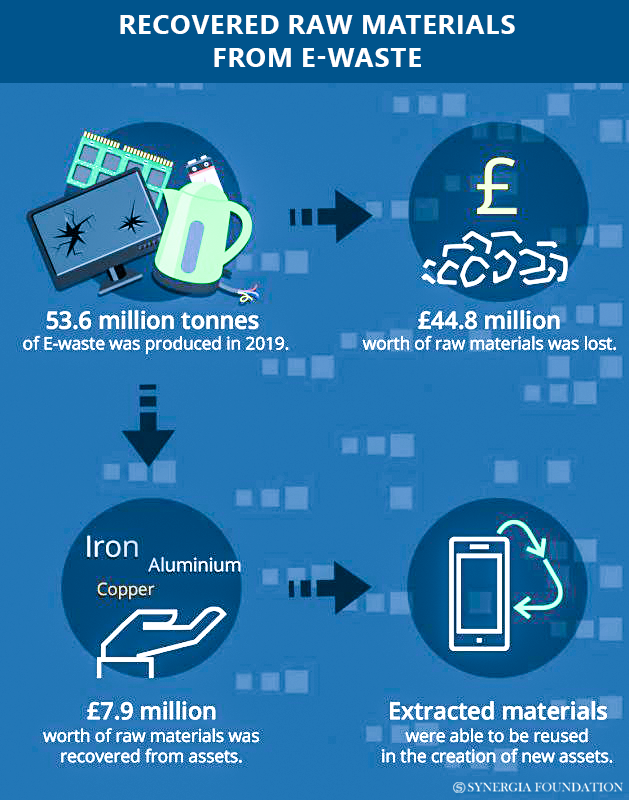Local First!
December 18, 2021 | Expert Insights

As the COVID-19 lockdown pushes us more inwards and homebound, the dependence on technology and electronics to remain connected increases exponentially. With newer strains of the virus emerging, it is critical to managing e-waste and ‘end-of-life goods’ more responsibly and with greater impact.
Background
Concerns for climate change have dominated global headlines, especially after the conclusion of the recent COP26 summit. As the world came together to address the world’s pressing climate concerns, one of the most significant aspects of domestic waste streams, namely electronic waste management, was conspicuously missing from its deliberations. Given the sizeable amount of minerals still present in the e-waste stream, can we really afford to miss such an important contributor to the circular economy?

Analysis
Electronic waste is the most rapidly growing waste stream globally, up by more than 20% in just five years, according to a United Nations study. With rapid urbanization and more recently, enforced lockdown and home-bound conditions, these would have only grown more rapidly over the last two years.
According to the United Nations (UN) Global Electronic Waste Monitor 2020, the amount of e-waste produced hit a record 53.6 million metric tonnes (Mt) in 2019 alone. By 2030, the world’s e-waste is projected to reach 74 Mt per year, which has shocking implications for the world. It is no surprise, therefore, that omission of e-waste disposal at COP26 discussions raised eyebrows. We need to move past an emphasis on creating solutions that reduce emissions, towards opportunities to promote and encourage the reuse and recycling of rare materials.
Currently, only 20 per cent of the global e-waste is recycled. But India’s numbers are particularly staggering, owing to the size of its population and rapid pace of urbanisation. According to the Global E-Waste Monitor 2017, India generates approximately 2 million tonnes (MT) of e-waste annually and ranks fifth among e-waste producing countries, after the U.S., China, Japan and Germany. In 2016-17, India had treated only 0.036 MT of its e-waste. Even now, about 95 per cent of India’s e-waste is recycled only in the informal sector and is either dumped in landfills or burnt.
In India, e-waste is growing at a compound annual growth rate (CAGR) of about 30 per cent and these numbers are only expected to multiply. The number of people handling these waste streams will also increase, posing significant risks to their health. Ensuring sustainable consumption, managing waste, promoting a healthy environment, and ensuring just and safe working conditions for waste pickers are urgent challenges.
Recycling of e-waste globally is at 17%, according to the Global E-waste Monitor 2020 report and though there is no such estimation for India, the country’s low recycling capacity (8 lakh tonnes annually) is worrying. Aside from the inability to mine precious materials from e-waste, these also present a serious health and environmental hazard because of the presence of toxic substances.
In India, the legislation to manage e-waste was established in 2011, stipulating that only authorised dismantlers and recyclers can collect e-waste. These Rules were brought into force to enable the recovery and/or reuse of useful material from e-waste, and to reduce dependence on landfills and unsafe disposal. The rules also covered components, consumables or parts or spares of Electrical and Electronic Equipment (EEE), along with their products. They also introduced the concept of Extended Producer Responsibility (EPR), which is the global best practice to ensure that manufacturers take back end-of-life products. Thereafter, the E-Waste (Management) Rules, 2016 were enacted which brought a manufacturer, dealer, refurbisher and Producer Responsibility Organization (PRO) under the purview of these Rules. Despite this legislative backing to safely process hazardous material, close to 80 per cent of e-waste continue to be broken down by the informal sector, at huge costs to health and the environment.
Given the multiple touchpoints where e-waste is generated, prominently at the household level, neighbourhood efforts to manage them have gained prominence in apartment complexes across India. In Bangalore, prompted by the Resident Welfare Associations (RWAs), a separate bin for e-waste is put in place which acts as an easy point for separate collection and disposal. In keeping with this trend, a number of registered recyclers and NGOs emerged, which facilitate the pick-up and disposal of e-waste. While these are certainly interesting examples, these efforts need to be scaled up in order to manage sufficient volumes of waste.

Venkatesh Shekar, Chief Environmental Officer (R), Karnataka State Pollution Control Board
In recent times, a considerable percentage of household municipal waste is electronic waste. A legislation to manage such e-waste was set up first in 2011 and there have been a series of amendments since to promote recycling of this waste stream. Extended producer’s responsibility was introduced in 2013 to encourage manufacturers to take responsibility of their equipment and reuse material in electronic waste. Waste segregation is the main starting point in responsible waste management but very few municipalities operate a separate bin for e-waste and as a result, collection and disintegration of materials is very difficult. Landfill and illegal dumping of waste remains the main route of waste disposal, while demand for electronic goods increases exponentially! Electronic waste outnumbers other wastes, if not recycled /reused, as this is non-biodegradable in nature. Only a meagre percentage (5%) of e-waste is collected, segregated and reused while the rest is left unattended.
Assessment
- As e-waste streams grow astronomically, perhaps an effective solution is to manage them at a household, community and neighbourhood level. Experience with RWAs have shown that this system both increases awareness and presents an effective solution to the safe disposal of e-waste
- A synchronized effort by industries, the pollution control boards and local authorities is crucial to cope up with the problem of e-waste in India. This will help manage the multiple touch points for e-waste generation while keeping legislation and its targets in the loop.








Comments